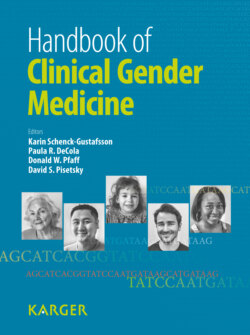Читать книгу Handbook of Clinical Gender Medicine - Группа авторов - Страница 38
На сайте Литреса книга снята с продажи.
References
Оглавление1 James WH: The human sex ratio. 1. A review of the literature. Hum Biol 1987;59:721–722.
2 James WH: The human sex ratio. 2. A hypothesis and a program of research. Hum Biol 1987;59:873–900.
3 Teitelbaum MS, Mantel N, Stark CR, et al: Limited dependence of the human sex ratio on birth order and parental ages. Am J Hum Genet 1971;23:253–270.
4 Aird J: Slaughter of the Innocents: Coercive Birth Control in China. Washington, AEI Press, 1990.
5 Greenhalgh S: Just One Child: Science and Policy in Deng’s China. Berkeley, University of California Press, 2008.
6 Johansson S, Nygren O: The missing girls in China: a new demographic account. Popul Dev Rev 1991;17:35–51.
7 National Bureau of Statistics of China: Press release on major figures of the 2010 national population census. 2011. http://www.stats.gov.cn/english/newsandcomingevents/t20110428_402722237.htm (accessed May 1, 2011).
8 Goodkind D: Child underreporting, fertility, and sex ratio imbalance in China. Demography 2011;48:291–316.
9 Shuzhuo Li: Imbalanced sex ratio at birth and comprehensive intervention in China. 4th Asia Pac Conf on Reprod and Sex Health and Rights, Hyderabad, 2007.
10 Guilmoto C, Oliveau S: Sex ratio imbalances among children at micro-level: China and India compared. Popul Assoc of America 2007 Annu Meet, New York, 2007.
11 Oster E: Hepatitis B and the case of the missing women. J Polit Econ 2005;113:1163–1216.
12 United States Census Bureau International Data Base. http://www.census.gov/ipc/www/idb/ (accessed May 1, 2011).
13 Population Division of the Department of Economic and Social Affairs of the United Nations Secretariat. http://esa.un.org/unpd/wpp/index.htm (accessed May 1,2011).
14 Chen Y, Li H, Meng L: Prenatal sex selection and missing girls in China: evidence from the diffusion of diagnostic ultrasound. 2011. http://nthu.hccg.org.tw/big5/down/%E5%AD%9F%E5%B6%BA%E7%94%9F.pdf.
15 Lutz W, Goujon A, KC S, et al: Reconstruction of population by age, sex and level of educational attainment of 120 countries for 1970-2000. Vienna Yearb Popul Res 2007; 193-235.
16 China 1982 population census data assembly. http://chinadataonline.org/member/census1982 (accessed May 1, 2011).
17 China 1990 population census data assembly. http://chinadataonline.org/member/census1990/ybListDetail.asp?ID=1 (accessed May 1, 2011).
18 All China Marketing Research: China census 2000.http://chinadataonline.org/member/census2000/.
19 China 1982 ten-percent inter-censal survey. http://chinadataonline.org/member/census1982s/ybListDetail.asp?ID=1.
20 China 2005 one-percent inter-censal survey. http://chinadataonline.org/member/census2005/ (accessed May 1, 2011).
21 Maddison A: Historical statistics for the world economy: 1-2008 AD. http://www.ggdc.net/maddison/ (accessed May 1, 2011).
22 World Bank: China quarterly update. 2008. http://siteresources.worldbank.org/INTCHINA/Resources/318862-121421293578/cqu_jan_08_en.pdf (accessed May 1, 2011).
23 Hemminki E, Wu Z, Cao G, et al: Illegal births and legal abortions: the case of China. Reprod Health 2005;2: 5.
24 China bans selective abortion to fix imbalance.China Daily, July 16, 2004. http://www.chinadaily.com.cn/english/doc/2004-07/16/content_349051.htm (accessed January 30, 2012).
25 Park CB, Cho NH: Consequences of son preference in a low-fertility society: imbalance of the sex ratio at birth in Korea. Popul Dev Rev 1995;21:59–84.
26 Statistics Korea: Birth statistics, 2009. http://kostat.go.kr/portal/english (accessed August 25, 2010).
27 Guilmoto C, Hoang X, Van TN: Recent increase in sex ratio at birth in Viet Nam. PLoS One 2008;4:e4624.
28 Guilmoto C: Sex Ratio at Birth-Imbalances in Viet Nam. Hanoi, UNFPA, 2010.
29 Vishwanath LW: Female Infanticide and Social Structure. New Delhi, Hindustan, 2000.
30 Guilmoto C: The sex ratio transition in Asia. Popul Dev Rev 2009;35:519–549.
31 Census of India: Sex ratio of total population and child population in the age group 0-6 and 7+ years: 2001 and 2011. http://censusindia.gov.in/ (accessed May 1, 2011).
32 Donahue D: Surprising sex ratios in the South Caucasus: son preference in the former Soviet states of Armenia, Azerbaijian, and Georgia. Conf of the Popul Assoc of America, Minneapolis, 2003.
33 Mesle F, Vallin J, Badurashvili I: A sharp increase in sex ratio at birth in the Caucasus. Why? How? in Attane I, Guilmoto CZ (eds): Watering the Neighbour’s Garden: the Growing Demographic Female Deficit in Asia. Paris, Committee for International Cooperation in National Research and Demography, 2007.
34 Almond D, Edlund L: Son-based sex ratios in the 2000 United States Census. Proc Natl Acad Sci USA 2008;105:5681–5682.
35 Dubuc S, Coleman D: An increase in the sex ratio of births to India-born mothers in England and Wales: evidence for sex-selective abortion. Popul Dev Rev 2007;33:383–400.
36 Hesketh T, Xing ZW: Abnormal sex ratios in human populations: causes and consequences. Proc Natl Acad Sci USA 2006;103:13271–13275.
37 Profamy: Software for family household projection.http://www.profamy.com/.
38 Yi Z, Wang Z, Leiwen J, et al: Projection of family households and elderly living arrangement in the context of rapid population aging in China – a demographic window of opportunity until 2030 and serious challenges thereafter. Genus 2008;64:9–36.
39 Wood R, Goesling B, Avellar S: The effects of marriage on health: a synthesis of recent research evidence. 2007. http://njwedding.org/business/report_marriage_on_health.pdf.
40 Becker G, Posner R (eds): Uncommon Sense: Economic Insights from Marriage to Terrorism. Chicago, University of Chicago Press, 2009.
41 Hvistendahl M (ed.): Unnatural Selection. New York, Public Affairs, 2011.
42 Hudson V, den Boer AM (eds): Bare Branches: the Security Implications of Asia’s Surplus Male Population. Cambridge, MIT Press, 2004.
43 Measure DHS: Demographic and health surveys.http://www.measuredhs.com.
44 WHO 2008 life tables: computed for the World Health Organization. World Health Statistics 2010. Geneva, WHO, 2010.
45 Chung W, Gupta MD: The decline of son preference in South Korea: the roles of development and public policy. Popul Dev Rev 2007;33:757–783.
46 Lavely, W: First impressions of the 2000 census of China. http://csde.washington.edu/pubs/wps/01-13.pdf (accessed October 15, 2002).
47 United Nations Statistics Division, Population Division of the Department of Economic and Social Affairs of the United Nations Secretariat: Demographic Yearbook 2008 — World Population Prospects: the 2010 Revision. http://esa.un.org/unpd/wpp/index.htm (accessed May 09, 2011).
Nicholas N. Eberstadt, PhD
American Enterprise Institute
1150 17th Street NW
Washington, DC 20036 (USA)
Tel. +1 202 862 5825, E-Mail eberstadt@aei.org
